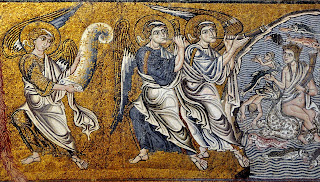The Antinomic Unity of Heaven and Hell
A fascinating excerpt from John Panteleimon Manoussakis, The
Ethics of Time: A Phenomenology and Hermeneutics of Change (Bloomsbury
Press, 2017).
The antinomic unity of heaven and hell was first introduced
by Origen in one of his early writings, the Exhortation to Martyrdom,
and was further developed in his refutation of Celsus. In the Exhortation to
Martyrdom we meet the idea of the self ’s division (διαίρεσις) and
separation (χωρισμός) from itself, or at least from a part of itself. Already
at this nascent stage, this theory is invoking the scriptural passage of 1 Cor.
3:10–15. Later in the same work the idea of the coincidence of salvation and
condemnation is articulated with the aid of a double metaphor: that of the
word of God as a sword that cuts through the self ’s interiority (based on Heb.
4:12), and that of God as a purifying fi re (attested in a number of scriptural
passages). These two metaphors are then combined in order to support the theory
that, at the end of times, the self in its duplicity will be “cut asunder” (διχοτόμησις):
all that is good in us will be preserved and thus saved; all that is evil will
be consumed by fire. In this image, both heaven and hell, salvation and
perdition is a common destiny awaiting every human being—they are both
universal.
The passage from the First Letter to the Corinthians details
the architecture of the human life: the whole scope of human endeavors is
compared to the material we have chosen to construct our lives. Their value and
truth will be tested only at the end, on the last day—if they shall endure the
coming of the eschaton then they will abide, otherwise, when he appears “like a
refiner’s fire” (Malachi 3:2), they will be lost, but the human person in
itself “will be saved” (1 Cor. 3:15):
According to the grace of God which
was given to me, as a wise master builder I have laid the foundation, and
another builds on it. But let each one take heed how he builds on it. For no
other foundation can anyone lay than that which is laid, which is Jesus Christ.
Now if anyone builds on this foundation with gold, silver, precious stones,
wood, hay, straw, each one’s work will become clear; for the Day will declare
it, because it will be revealed by fire; and the fire will test each one’s work,
of what sort it is. If anyone’s work which he has built on it endures, he will receive
a reward. If anyone’s work is burned, he will suffer loss; but he himself will be
saved, yet so as through fire.
Origen offers the following interpretation on this Pauline
passage:
The divine word says that our God
is “a consuming fire” and that “He draws rivers of fire before him;” nay, that
He even appears as “a refiner’s fire and a fuller’s herb,” to purify His own
people. But when he is said to be a “consuming fire,” we inquire what are the
things which are appropriate to be consumed by God. And we assert that they are
wickedness, and the works which result from it, and which, being figuratively
called “wood, hay, straw,” God consumes as fire. The wicked man, accordingly,
is said to build up on the previously-laid foundation of reason, “wood, and
hay, and straw.” ... And thus He appears as a “refiner’s fire,” to refine
the rational nature, which has been filled with the lead of wickedness, and to
free it from the other impure materials, which adulterate the natural gold or
silver, so to speak, of the soul. And, in like manner, “rivers of fire” are
said to be before God, who will thoroughly cleanse away the evil which
intermingled throughout the whole soul.
Origen’s reading of the Pauline text was received by the
Greek Patristic tradition under the authority of such thinkers as Gregory of
Nyssa and Maximus the Confessor. St. Theodore the Studite, a ninth-century
Byzantine monk, summarizes the long tradition of this interpretation in a
passage from his Letters when writing:
This is nothing else…than what the
Apostle [Paul] dogmatized, namely that the work of sin will be consumed by fire,
while he [who committed the sin] will be saved unscathed by fire, yet not by
participating to the good, but by having realized his deprivation of such
participation. For what is from God, namely our nature, being originated from
what really is [ἐκ τοῦ ὄντος], is indestructible by that fire. That, however,
which is not from God, namely sin, having come to be by the sinner’s choice,
since it is not some being, but something accidental [παρυφιστᾶσα], it cannot
be classified together with what is [τοῖς οὖσιν], and therefore it will be undone.
At first sight, Origen’s and Theodore’s readings seems to
lead to the well-known position of apokatastasis, that is, of the
eschatological restoration of all, for which Origen was later condemned.
However, this is not necessarily so. For one could raise two questions: firstly,
“how much” of the self is lost as a result of this purification, provided that
one’s life may be entirely or mostly built by the material of wickedness? And secondly,
how long does this trial by fire last—or rather for how long may the self that undergoes
such a burning purification perceive this process as lasting?
[Below: Mosaic of the Last Judgment, Church of Santa Maria Assunta, Torcello]





Comments
Post a Comment